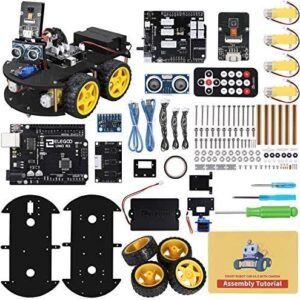In recent years, the concept of autonomous systems has transitioned from mere science fiction to a tangible reality, reshaping industries from transportation to healthcare. At the heart of this transformation lies machine learning—a subset of artificial intelligence that enables systems to learn from data, adapt over time, and make intelligent decisions without human intervention. As technologies like self-driving cars, drones, and robotic assistants become increasingly sophisticated, understanding the intricate relationship between machine learning and autonomy is crucial. This article delves into the transformative role that machine learning plays in powering these systems, exploring its applications, challenges, and the implications for our future. Join us as we uncover how these intelligent machines are set to revolutionize the way we live and work.
Table of Contents
- The Role of Machine Learning in Enhancing Decision-Making for Autonomous Systems
- Integrating Sensor Data with Machine Learning for Improved Real-Time Navigation
- Safeguarding the Future: Ensuring Safety and Ethical Standards in Autonomous Technologies
- Building a Workforce of the Future: Skills and Education Requirements for Machine Learning in Autonomous Systems
- To Wrap It Up
The Role of Machine Learning in Enhancing Decision-Making for Autonomous Systems
Machine learning (ML) is at the forefront of revolutionizing decision-making processes in autonomous systems, enabling these technologies to analyze vast amounts of data and make informed choices in real-time. By leveraging algorithms that can learn from experience, autonomous systems can adapt to changing environments and user preferences, which is essential for tasks ranging from self-driving cars to robotic process automation. Some of the key advantages include:
- Predictive Analytics: ML models can forecast potential outcomes based on historical data, allowing systems to anticipate and respond to scenarios effectively.
- Enhanced Accuracy: Continuous learning from data improves the precision of decisions, minimizing errors in dynamic environments.
- Adaptive Behavior: Autonomous systems can learn from their surroundings and user interactions, enhancing their ability to operate in unpredictable situations.
Moreover, the integration of these intelligent systems necessitates a robust decision-making framework that prioritizes safety and efficiency. For instance, the following factors are pivotal:
| Factor | Description |
|---|---|
| Data Quality | High-quality data leads to better learning outcomes and decision precision. |
| Real-time Processing | Instant data analysis facilitates prompt decision-making in critical scenarios. |
| Ethical Considerations | Decisions made by autonomous systems must align with ethical standards to ensure user trust and safety. |
As machine learning continues to evolve, its role in shaping decisions for autonomous systems will not only enhance operational functionalities but also redefine the boundaries of innovation across industries.
Integrating Sensor Data with Machine Learning for Improved Real-Time Navigation
Integrating sensor data with machine learning algorithms significantly enhances the capabilities of real-time navigation in autonomous systems. By leveraging various data inputs such as GPS, LiDAR, cameras, and inertial measurement units, these systems can gather a comprehensive understanding of their environment. This array of data allows machine learning models to recognize patterns, identify obstacles, and predict dynamic changes, giving autonomous vehicles a heightened level of situational awareness. Some of the critical components for successful integration include:
- Sensor Fusion: Merging data from multiple sensors to improve accuracy and reliability.
- Real-Time Processing: Utilizing edge computing to analyze data instantly, reducing latency.
- Model Training: Continuously refining algorithms with new data to enhance navigation precision.
The synergy between sensor data and machine learning also enables adaptive navigation strategies that can respond to unpredictable conditions. For example, when facing obstacles like road construction or heavy traffic, machine learning models can dynamically alter routes based on the real-time data collected from sensors. Below is a table highlighting some popular sensor technologies and their applications in navigation:
| Sensor Technology | Application |
|---|---|
| GPS | Location tracking and mapping |
| LiDAR | 3D mapping and obstacle detection |
| Cameras | Object recognition and environment perception |
| IMU | Motion sensing for navigation accuracy |
This integration not only improves the safety and efficiency of autonomous systems but also propels them toward achieving more complex tasks that require higher levels of intelligence and adaptability in navigation.
Safeguarding the Future: Ensuring Safety and Ethical Standards in Autonomous Technologies
As autonomous technologies integrate deeper into our daily lives, the imperative to safeguard their development and deployment becomes essential. Machine learning plays a crucial role in enhancing these systems’ capabilities, yet it also necessitates a robust framework for safety and ethical standards. The complexity of algorithms driving decision-making processes requires transparency, ensuring that these systems can be audited and understood by developers, users, and regulators alike. This can be achieved through:
- Robust Testing: Comprehensive testing protocols must be established to evaluate system responses across a range of scenarios.
- Ethical AI Guidelines: Developing guidelines that prioritize fairness, accountability, and inclusivity in machine learning models.
- User Education: Informing users about how autonomous systems function and their potential risks fosters a mutually respectful relationship between technology and society.
Furthermore, collaboration among stakeholders—such as tech companies, policymakers, and academia—is vital in shaping the future of artificial intelligence responsibly. The implementation of ethical standards should not only aim to mitigate risks but also encourage innovation in a safe environment. For a clearer understanding of the current landscape, consider the following table outlining popular autonomous technologies and their primary applications:
| Technology | Primary Application | Safety Considerations |
|---|---|---|
| Self-driving Cars | Transportation | Collision avoidance, real-time decision making |
| Drones | Aerial Surveillance | Airspace regulation, privacy concerns |
| Healthcare Robots | Patient Assistance | Data privacy, reliability in caregiving |
Building a Workforce of the Future: Skills and Education Requirements for Machine Learning in Autonomous Systems
As the demand for autonomous systems continues to escalate, the workforce must adapt by embracing a diverse array of skills and educational pathways. Machine learning engineers, data scientists, and systems developers will form the backbone of this evolving landscape. Essential skills include:
- Programming Proficiency: Mastery of languages such as Python, R, or Java is crucial for developing algorithms.
- Mathematical Expertise: A strong foundation in statistics and linear algebra supports data manipulation and model design.
- Understanding of Machine Learning Frameworks: Familiarity with TensorFlow, PyTorch, or Keras is increasingly important for rapid development.
- Data Handling Skills: The ability to efficiently preprocess, augment, and analyze large datasets is vital.
- Communication and Teamwork: As interdisciplinary collaboration becomes more common, soft skills are equally essential.
Educational institutions must revamp their curricula to prepare students adequately. Programs should not only focus on theoretical aspects of machine learning but also integrate practical, hands-on experiences through internships and projects. A table outlining potential educational pathways highlights the diversity of options available to aspiring professionals:
| Degree Level | Course Focus | Typical Duration |
|---|---|---|
| Bachelor’s | Computer Science or Data Science | 3-4 years |
| Master’s | Artificial Intelligence or Machine Learning | 1-2 years |
| PhD | Specialized Research in Autonomous Systems | 3-5 years |
To Wrap It Up
As we venture further into the realm of autonomous systems, it becomes increasingly clear that machine learning is not just an enabler but a fundamental force driving innovation. From smart vehicles to robotic assistants and autonomous drones, the applications of ML are bridging the gap between human intuition and machine efficiency, paving the way for a future teeming with possibilities.
The profound impact of this technology extends beyond convenience—enhancing safety, optimizing operations, and revolutionizing entire industries. As machine learning algorithms continue to evolve, they will empower these systems to learn and adapt, making them more responsive, reliable, and resilient.
However, with great power comes great responsibility. It’s vital for stakeholders to prioritize ethical considerations, transparency, and regulatory frameworks to ensure that the advancements in autonomous systems align with the values of society.
As we unlock the potential of machine learning in autonomous systems, collaboration among technologists, policymakers, and the public will be essential in shaping a future that is not only innovative but also equitable and sustainable. The road ahead is thrilling, and we are only at the beginning of this journey. Join us as we explore and embrace the remarkable possibilities that machine learning holds for the future of autonomous systems!





